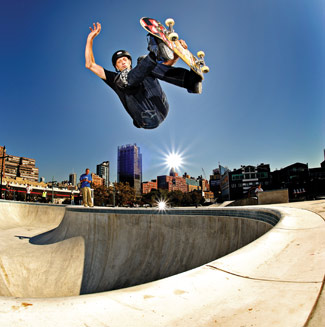 It’s always fun playing the what-if game. As in, what if you fell asleep on a park bench in 1980 and woke up in 2011. What might you see? Kids cavorting on skateboards traversing impossibly steep and contoured ramps. That’s no swimming pool, it’s a wave pool and kids are surfing on it. You’d swear you’re seeing a wild game of polo being played on bikes on a dedicated court. While in the distance golf is being played with Frisbees. Perhaps most baffling will be those hand-held satellite devices being used in a scavenger hunts, the likes of which you’ve never seen before. And where did that faux mountain come from with dozens of people rappelling up and down? If you didn’t know better, you’d swear parks have gone to the kids. And you’d be right—parks have always been for the young and young at heart.
It’s always fun playing the what-if game. As in, what if you fell asleep on a park bench in 1980 and woke up in 2011. What might you see? Kids cavorting on skateboards traversing impossibly steep and contoured ramps. That’s no swimming pool, it’s a wave pool and kids are surfing on it. You’d swear you’re seeing a wild game of polo being played on bikes on a dedicated court. While in the distance golf is being played with Frisbees. Perhaps most baffling will be those hand-held satellite devices being used in a scavenger hunts, the likes of which you’ve never seen before. And where did that faux mountain come from with dozens of people rappelling up and down? If you didn’t know better, you’d swear parks have gone to the kids. And you’d be right—parks have always been for the young and young at heart.
Study after study shows how parks keep the young fit and healthy and older generations fit, healthier, and younger than their non-indulging counterparts. Our profile on Tony Hawk this month captures this duality in spades. At 37, the iconic skateboarder straddles that tenuous and shifting line between young and young at heart. Still intrepid on a skateboard 28 years after his first try, Hawk has not only made a commercial career in the sport, but has also created a nonprofit foundation to promote and fund skateboard parks. In this article Hawk advises prospective developers of skateparks to make them reflect public properties—for the sake of the skater, who will tend to take a more active interest in his or her community. At the same time, by involving the young users in the overall development process, planners and community leaders will teach youth to care more about their communities.
It shows that enlightened communities listen to their fellow citizens, young and old(er). Like our Rip van Winkle of 1980, you cannot anticipate recreational trends very far into the future, but you can have an open mind as they evolve. As Hawk tells PARKS & RECREATION this month, “Parents are encouraging kids to skateboard; dads are out there skating with their kids and having fun; skateboarding is the most diverse sport in the world, and this is something communities can stand behind.”
What if communities and park advocates hadn’t cooperated in recognizing the merits of these new additions to their recreation offerings, from skateboarding to bike polo? My guess is that those communities would instead be dealing with a generation of disconnected youth and dissatisfied young at heart. Parks have come too far for that.
Phil Hayward is the Editor for Parks & Recreation magazine.

